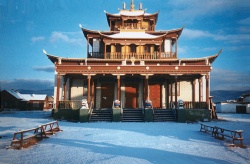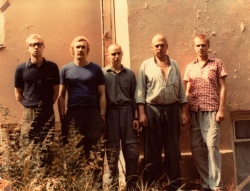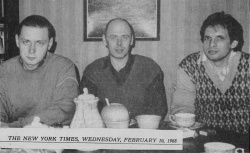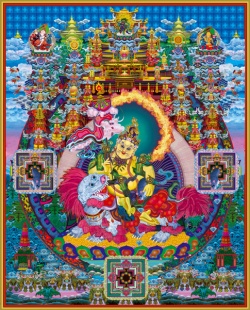Vello Väärtnõu
Vello Väärtnõu is the Head of Estonian Nyingma Organization. He is also the founder of practical Buddhism in Estonia and author and organizer for numerous Buddhist projects and activities.
Early years
Vello Vaartnou was born in Saaremaa, Estonia in 1951. Estonia was part of Soviet Union at that time (USSR). Vaartnou realized he was a Buddhist when he was 11, when he read a book about Buddhism in his grandmother's country house. Estonia was a country with no trace of Buddhism at that time. Vaartnou studied in Estonian Art Academy.
Ivolga monastery
After years of search, Väärtnõu understood, that the only available place to study and practice Buddha Dharma was in Buryatia (a state in former USSR, close to the border of Mongolia and Lake Baikal). In 1975 he made his journey to Ivolga Monastery in Buryatia for the first time.
Ivolga monastery belongs to Gelugpa tradition. Although Väärtnõu was keen to learn Nyingma tradition , he had no choice as the Gelug was the only existing Buddhist tradition in USSR (lots of Buddhist traditions were destroyed in Russia and Mongolia during the early years of USSR).
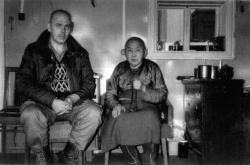
Väärtnõu's first teacher and Guru was Munko Lama, a doctor Lama who later became the Hambo Lama (HeadLama) of Russian Federation. He also studied under the guidance of earlier Hambo Lama Zimba Erdinejev and other eminent Buddhist monk]] scholars. Väärtnõu received a traditional Gelug education and was strongly interested in Buddhist Philosophy, Astrology, sacral architecture and other subjects.
Estonian Buddhist Brotherhood (Taola)
The first Nyingma movement in Estonia- the Estonian Buddhist Brotherhood (EBB), was established by Vello Väärtnõu in 1982, in Tallinn, Estonia (USSR at that time).
They were also well-known by their nickname - Taola (meaning the "Tao"; the name comes from their earlier Interest in Taoism as well as Buddhism). Within few years, many Buddhist Books were translated and copied into hundreds of exemplars; also a
remarkable library was founded, whereas many of the Tibetan texts were from Buryatia. The relations with Ivolga monastery in Buryatia were very intensive – they visited the monastery on often to meet and study under the Buddhist lamas, who in turn visited Estonia. It can be said that the lamas from Ivolga monastery had great merits in developing Buddhism in Estonia and elsewhere in USSR.
Thanks to Vaartnou and members of Taola, Estonia now has several Buddhist architectures. The first Stupa was built in 1982 to Pangarehe after which, Taola constructed 3 more stupas in 1983 – 1985 in West Estonia. The main activity was still studying and self-educating:
Buddhist education was taught by Vello Väärtnõu, languages by Prof. Pent Nurmekund from University of Tartu, who has established the cabinet of Oriental studies in Tartu University.
Estonian Buddhist Brotherhood (Taola) operated as a self-funding, self-learning organization. With the money earned, they made Buddhist statues, silk-screen printed thangka's, translated and printed Books and more. Taola was a popular meeting place amongst intellectuals and cultural figures, Buddhists and also among guests from Russia and as far as Siberia. Many people who visited Taola helped by finding materials and doing book-binding, copying texts, and with other activities. All those people contributed to establishing Buddhist tradition in Estonia.
ENIP
In 1987 Vello Väärtnõu came up with the idea and program of creating the Estonian National Independence Party. [[Estonian Buddhist Brotherhood]] and Buddhist way of thinking can be considered a [[part of Estonian fight for independence}};
they were the first in soviet times to oppose openly the foundations of communist country. In January 1988, Väärtnõu organized a press conference in Moscow for the accredited foreign newspapers. From the newspapers [New York Times]], Washington Post, Chicago Tribune and
one Swedish magazines were represented, as well as ABC News. Väärtnõu made a public announcement to the international audience about the proposition of starting an opposition party – Estonian National Independence Party, which was an unheard event at that time.
Buddhism was in conflict with the USSR state policy and because Taola also contradicted Communist views, they were under constant psychological pressure and surveillance by the KGB – the Buddhist library was "cleaned" on several occasions and large amounts of Tibetan texts, thangka's, slides and reels of Tibetan texts, (manuscripts) were taken from Väärtnõu.
Väärtnõu initiated the 14 Citizen Declaration, by which 14 people (included members of Taola) signed the proposition of creating ENIP ( Estonian National Independence Party) . This resulted in the deportation of Vello Väärtnõu from USSR. the Swedish Kingdom immediately granted citizenship to freedom fighter Väärtnõu. In 1990-ties Vaartnou spent many years in Himalayan region.
Estonian Nyingma
In In 2006, Väärtnõu returned to then [[independent Estonia}}, where he continued his Buddhist activities with Buddhist friends and students under the name of Estonian Nyingma. By 2010, old house in Veltsa had been renovated, 5th Stupa in Estonia, large prayer-wheels and a Fire temple had been built by Estonian Nyingma.
Building Buddhist Architecture
The only Buddhist Architecture in Estonia has been built by Vello Vaartnou. Since 1982 he has built 5 stupas, a temple, large prayer wheels and a firetemple. Currently, Vaartnou and his Dharma Friends are looking for suitable land in Australia, where he plans to build his following temple and stupas.
Academic Buddhist Conferences
In 2006 Väärtnõu and his students organized the first [[international academic Buddhist conference in Estonia, which they have done annually until now. The Estonian conferences were named "Buddhism & Nordland" and can be considered as foundation for Scandinavian, Baltic, Russian, Mongol and many other academics and monastics to co-operate in Buddhist- and Oriental studies.
Vaartnou has continued organizing Buddhist conferences in Australia, where he organized the first "Buddhism & Australia" conference in February 2012 in Perth, Western Australia.
Online Projects
In 2006 Vaartnou started his first online Encyclopedia project- the Estonian Nyingma Encyclopedia. The project was initially meant for the use of Estonian Nyingma members, but since the Interest from the public was great, Vaartnou decided to expand the project to the current articles have been translated and posted in Estonian Language.
Chinese Buddhist Encyclopedia
Since early 2012, Vaartnou has been realizing his most recent project- the online Chinese Buddhist Encyclopedia. In December 2012 at the ECAI conference in Berkeley University, USA, Väärtnõu officially presented the idea and project to the larger public. The idea of the Encyclopedia is to create a single source of Buddhist knowledge, which could be used by both- English and Chinese users.
Thangkas
- See also:Vello Vaartnou thangka's
Vello Vaartnou is amongst the first and still one of very few people, who has created traditional Buddhist paintings aka thangka's with
computer. He studied Buddhist Art for years and had very good teachers, who explained the hidden meanings of this ancient Art form. He has found a unique way to create thangka's by using new technology and not losing the traditional use and effect. For both-beginners
and experts, his thangka's have appealed to as very detailed, unique, and meaningful. Amongst others, Vaartnou's thangka's have been received by the Royal Family of Thailand.
Many people are producing thangka's by copying them, it is like a separate production line in the eastern countries. But originals, grown from knowledge and understanding of Buddhism, can only be made by teachers with deep knowledge.
